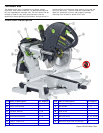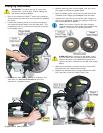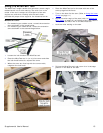
Supplemental User’s Manual 5
Service
► To reduce the risk of serious or fatal injury, never
open the motor housing. Have your power tool
serviced only by a qualified repair person using only
identical replacement parts.
► Any repairs to the laser must be carried out by the
laser manufacturer or by an authorized agent of the
laser manufacturer. Never attempt to replace the laser on
this tool with a different type of laser.
Specific Safety Rules for Miter Saws
► To reduce the risk of serious or fatal injury, never alter
or misuse the power tool.
► Be certain the miter saw is mounted or securely placed
on a level, firm work surface before using. A level and
firm work surface reduces the risk of the miter saw becoming
unstable or tipping.
► Make sure all controls and clamping handles are
secured before starting any operation. Unsecured
clamps or adjustment handles can cause the saw and/or
workpiece to move unexpectedly.
► Always unplug the saw before servicing or changing
the sawblade.
► Never remove or disable the blade guard. Inspect the
blade guard before use. Repair or replace a damaged or
improperly functioning blade guard before further use.
► Keep hands out of the path of the sawblade. Never
cross your hand over intended line of cutting.
Supporting the workpiece “cross handed” e.g. holding the left
side of the workpiece with your right hand, is very
dangerous.
► Do not reach in back of the moving saw blade with
either hand to remove wood scraps, hold down or
support the workpiece, or for any other reason. The
proximity of the spinning saw blade to your hand may not be
obvious and you may be seriously injured.
► Use clamps to support workpiece whenever possible.
Do not use this saw to cut pieces that are too small to
be securely clamped.
► Clamp the offcut side of the workpiece when using a
length stop. An unsecured offcut can bind between the
length stop and the saw blade.
► If securing the workpiece by hand, you must always
keep hands outside of “No Hand” area as marked with
a symbol on the base. Your hand, if placed inside the “No
Hands” region, can easily slip or be pulled into the blade.
► Support long workpieces to prevent them from tipping.
A tipping workpiece can lift up and contact the spinning
sawblade, or bring the operator’s hand upward into the
blade.
► For proper control, never “pull” the saw through the
cut, always chop or push cut. See page 17 of this manual.
► Cut only one workpiece at a time. Multiple workpieces
cannot be adequately clamped or braced and may bind on
the blade or shift during cutting.
► Keep workpieces firmly against the rear fence when
cutting. Never cut workpieces that do not lay flat or
are curved in any way. A curved workpiece can be grabbed
by the blade and propelled back against the fence.
► Inspect workpieces for nails or foreign objects. Make
sure there are no tools or foreign objects on the saw.
► Do not cut round stock unless it is clamped in such a
way as to prevent rotation. Round stock will tend to roll
while it is being cut.
► Use only sawblades recommended by the
manufacturer and designed for use with the saw, with
a 30mm arbor bore, a 260mm diameter, and a
maximum thickness of 2mm. Be sure that the speed
marked on the saw blade is at least equal to the speed
marked on the saw. Do not use high speed steel saw
blades.
► Select the correct saw blade for the material to be cut.
Do not use the saw to cut materials other than those
recommended by the manufacturer. Never force the tool
or attachment to do a job for which it was not designed.
► Never use this saw for cutting ferrous metals.
► Never use saw blades that are damaged or deformed.
Never use a dull sawblade. A dull sawblade places undue
stress on the saw and the workpiece and can increase the
risk of kickback.
► Make sure the sawblade is securely installed and is not
backward. The arrow on the blade should match the
direction of the arrow marked on the tool.
Respiratory Exposure Safety Warnings
Substantial or repeated inhalation of dust and other airborne
contaminants, in particular those with a smaller particle size,
may cause respiratory or other illnesses. Various dusts
created by power sanding, sawing, grinding, drilling and other
construction activities contain chemicals or substances known
(to the State of California and others) to cause cancer, birth
defects or other reproductive harm. Some examples of these
chemicals/substances are:
► lead from lead-based paints;
► crystalline silica from bricks, cement, and other masonry
products;
► arsenic and chromium from chemically-treated lumber; and
► some wood dusts, especially from hardwoods, but also from
some softwoods such as Western Red Cedar.
The risk from these exposures varies, depending on how often
you do this type of work. To reduce your exposure to these
chemicals: work in a well ventilated area and use a properly
functioning dust extraction system. When the inhalation of
dust cannot be substantially controlled, i.e., kept at or near
the ambient (background) level, the operator and any
bystanders should wear a respirator approved by NIOSH for
the type of dust encountered.
Tool Description
Technical Specifications
Power Consumption 1600 Watts (13 amps @ 120 volts) Max. Depth (tall) 120 mm (4.75”) at 60 mm (2.3”)
Motor Speed 1400 - 3400 RPM (no load) Max. Depth at 45° Bevel 55mm (2.2”)
Arbor Diameter 30 mm Max. Width at 90° Miter 305mm (12”)
Max. Blade Size 260 mm (10.25”) dia., 2mm (
5
/
64
”) thick
Max. Width at 45° Miter 210mm (8.25”)
Max. Depth (std.) 88 mm (3.46”) Weight 21.5 kg (47.3 lbs)
All metric dimensions are controlling. The arbor diameter is critical for safe operation, and is presented in metric only.


















